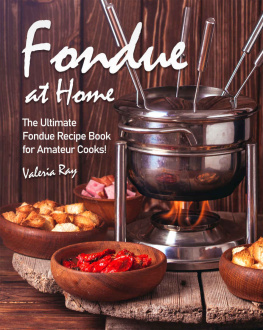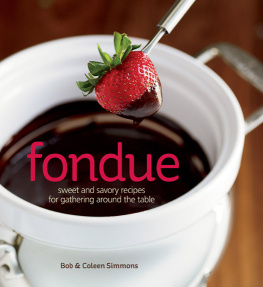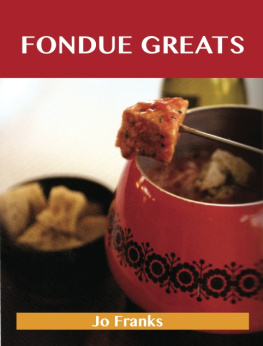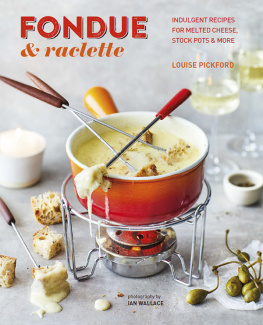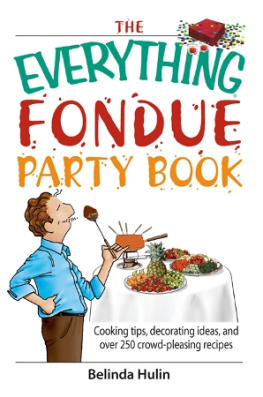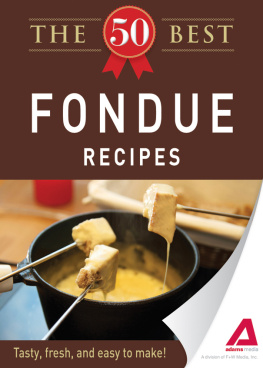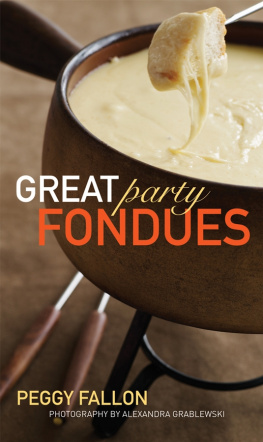
Table of Contents
THE HARVARD COMMON PRESS
535 Albany Street
Boston, Massachusetts 02118
www.harvardcommonpress.com
Copyright 2010 by Hallie Harron
Photographs copyright 2010 by Joyce Oudkerk Pool
All rights reserved. No part of this publication maybe reproduced or transmitted in any form or by
any means, electronic or mechanical, including photocopying, recording, or any information storage
or retrieval system, without permission in writing from the publisher.
Printed in China
Printed on acid-free paper
Library of Congress Cataloging-in-Publication Data
Harron, Hallie.
Not your mother's fondue / Hallie Harron.
p. cm.
Includes index.
ISBN 978-1-55832-439-8 (hardcover : alk. paper)ISBN 978-1-55832-438-1 (pbk. : alk. paper)
1. Fondue. I. Title.
TX825.H57 2010
641.8'1dc22 2009050012
Special bulk-order discounts are available on this and other Harvard Common Press books.
Companies and organizations may purchase books for premiums or resale, or may arrange a
custom edition, by contacting the Marketing Director at the address above.
Book design by Ralph Fowler / rlf design
Photographs by Joyce Oudkerk Pool
Food and prop styling by Jen Straus
10 9 8 7 6 5 4 3 2 1
Not Your Mother's is a registered trademark of The Harvard Common Press.
To Serene da Vie,
my California source
of constant inspiration
and guidance

Acknowledgments
Thank you to Gary and Marilyn Litt for your hints and suggestions, and for the music that filled our fondue testing with great ambiance. A huge merci to Jay and Fran London for your meticulous testing notes, and, finally, thanks to all the neighbors and friends in Encinitas, California, and Mollans-sur-Ouvze, France, who managed to help taste and test all of these recipes.

FONDUE BASICS
After almost three decades, fondue is back at the top of the list of home-entertainment options, with all kinds of new and exciting themes and variations. Now is the time to dust off those fondue pots, call friends to come over, and prepare some imaginative dippers for the vast variety of fondues you can make at home.
Before jumping into the recipes, here are few historical notes, as well as some tips to make you an instant expert in the field of fondue. Read on for a look at how to select everything you'll need to get started, from pots to dippers, as well as suggestions on how to round out the meal with side dishes and complementary beverages.
Where and When Did the Meltdown Begin?
Historians are in a quandary. Was it the sixteenth-century siege in Zurich, when famine led to fondue out of necessity, or was it the thrifty eighteenth-century Swiss housewives who were looking for a creative way to use stale bread, leftover wine, and cheese scraps? Whenever the actual first melting down of cheese and wine took place, generations later we can all be grateful it happened, because fondue is with us now and is here to stay.
We do know that some of the best early fondues were said to hail from Switzerland's canton, or district, of Neuchtel, where there was an abundance of Emmenthaler and Gruyre cheeses, lovely Neuchtel wine, and, of course, bread. The caquelon, a heavy pot, was used to melt and whisk everything together. This produced suppers that were filling and delicious and gave the family plenty of time to spend at the table on cold, long, rough winter evenings.
Since there was usually only one pot per household, it went into the center of the table, and bread cubes were speared and dipped communally. The whole process of participation became so popular that it soon spread to other districts. Today each Swiss canton has its own special version of fondue using cheeses and wines unique to the area. For example, the area of Geneva makes fondue using Gruyre and Emmenthaler cheeses and, often, minced wild mushrooms. Eastern Switzerland uses Appenzeller and Vacherin cheeses melted with strong apple cider in its fondue, and yet another canton, the area surrounding Fribourg, serves a fondue that involves diners first dipping their bread cubes in plum schnapps before coating them with the melted cheeses. Kirsch or other fortified brandies and schnapps are a part of the fondue recipe in many areas. The result of these different traditions gives each canton its own special claim to fondue fame.
Prior to the 1970s, fondue was a relatively unknown dish in the United States. But suddenly in the late 1960s and 1970s, fondue sets exploded onto the scene and became a hot item, especially for new brides. (I know I received at least three of them!) During that era, Americans began to experiment with traditional fondue recipes, and eventually dessert fondues surfaced. As the years passed, though, fondue sets were relegated to garage and white-elephant sales. Sadly, fondue lay dormant for a couple of decades and was considered pass. Luckily, in the new millennium we are rediscovering, with the help of the "slow food" movement, the importance of taking time with family and friends at the table. Also, given today's busy lifestyles and people's strong desire for easy meal preparation, fondue feasts are a simple, inexpensive way to feed a crowd of friends, listen to their tales, and enjoy a casual evening together.
So it's now time for your own fondue set to come out of the closet and get dusted off! Or make a modest investment in a sturdy, stylish new set; either way, get ready for lots of creative meals filled with delicious treats and relaxed fun.
Beyond Basic Fromage
There are five basic categories of fondue in this book: cheese, sauce, oil, broth, and dessert.
Of course, I offer several recipes for classic cheese versions. Look for new combos, too, like rich Camembert and Mushroom Fondue () featuring fontina cheese. Modern melted-cheese concoctions are in keeping with the Swiss tradition and are extremely popular. The good news is that cheeses from around the globe are readily available across the United States in supermarkets and specialty shops and by Internet mail-order. Ditto on the wines to be mixed into the fondue. You can plan a traditional cheesy feast from Switzerland or you can branch out and try melted cheeses heated with wine and spirits from Mexico, South America, Spain, Italy, Greece, France, and beyond.
Keep in mind that there is a whole world of fondue that goes way beyond cheese. I also offer recipes for saucy fondues, in which a traditional sauce typically used for cloaking meats and vegetables is set in the center of the table for diners to dip into to their hearts' content. Try the Creamy Dill Fondue for Salmon (), where you dip pizza crust and traditional toppings into the pizza sauce.
Oil fondues both classic and nouveau are also a major part of the book and should be in every fondue master's repertoire. Spearing tender beef cubes and searing them in oil at the table, with scrumptious sauces to dip them into, can be a wonderful way to spend a casual yet elegant evening with friends. These classic oil-based fondues are simple and require only the cutting up of the "dippers," or meats and vegetables, and assembling some sauces or dips for the cooked dippers. Be prepared to love many Mediterranean oil-based fondues, such as Bagna Cauda () that will make the long-cooked traditional stew easy, accessible, and great fun for a celebration.
Next page


